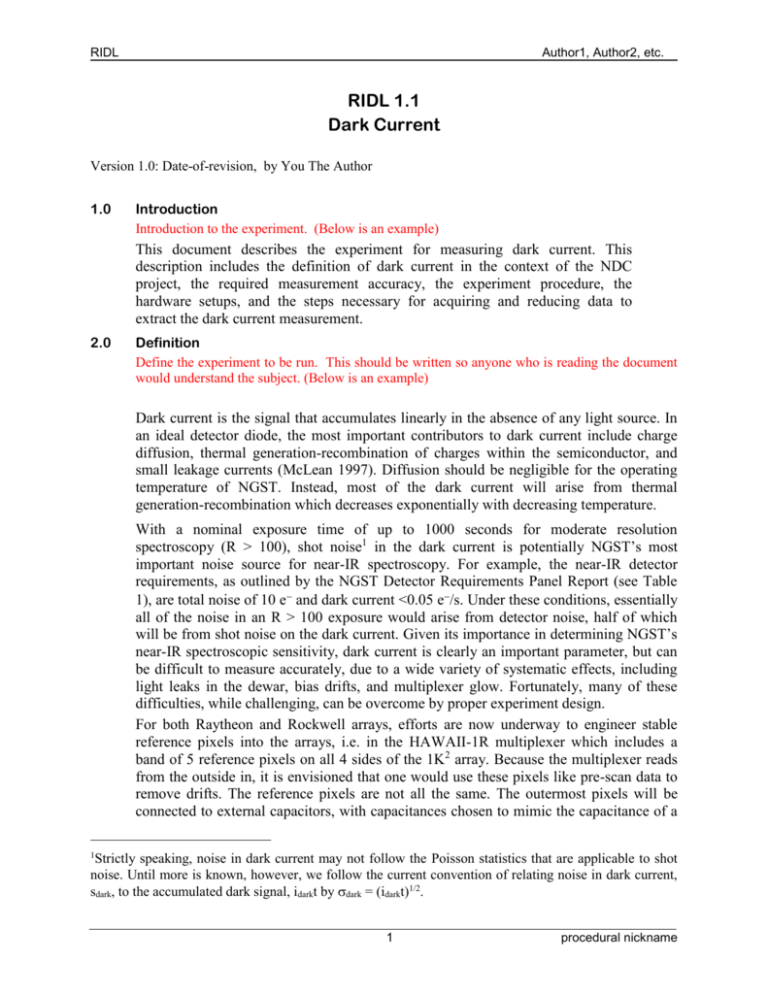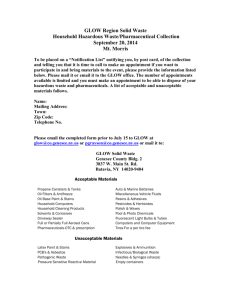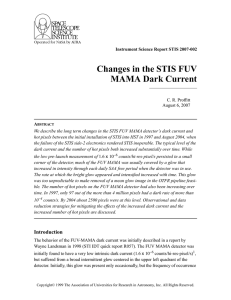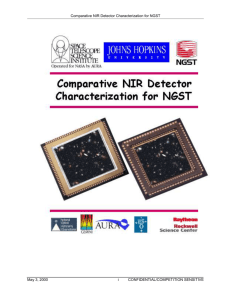RIDL Experiment Template.doc
advertisement

RIDL Author1, Author2, etc. RIDL 1.1 Dark Current Version 1.0: Date-of-revision, by You The Author 1.0 Introduction Introduction to the experiment. (Below is an example) This document describes the experiment for measuring dark current. This description includes the definition of dark current in the context of the NDC project, the required measurement accuracy, the experiment procedure, the hardware setups, and the steps necessary for acquiring and reducing data to extract the dark current measurement. 2.0 Definition Define the experiment to be run. This should be written so anyone who is reading the document would understand the subject. (Below is an example) Dark current is the signal that accumulates linearly in the absence of any light source. In an ideal detector diode, the most important contributors to dark current include charge diffusion, thermal generation-recombination of charges within the semiconductor, and small leakage currents (McLean 1997). Diffusion should be negligible for the operating temperature of NGST. Instead, most of the dark current will arise from thermal generation-recombination which decreases exponentially with decreasing temperature. With a nominal exposure time of up to 1000 seconds for moderate resolution spectroscopy (R > 100), shot noise1 in the dark current is potentially NGST’s most important noise source for near-IR spectroscopy. For example, the near-IR detector requirements, as outlined by the NGST Detector Requirements Panel Report (see Table 1), are total noise of 10 e and dark current <0.05 e/s. Under these conditions, essentially all of the noise in an R > 100 exposure would arise from detector noise, half of which will be from shot noise on the dark current. Given its importance in determining NGST’s near-IR spectroscopic sensitivity, dark current is clearly an important parameter, but can be difficult to measure accurately, due to a wide variety of systematic effects, including light leaks in the dewar, bias drifts, and multiplexer glow. Fortunately, many of these difficulties, while challenging, can be overcome by proper experiment design. For both Raytheon and Rockwell arrays, efforts are now underway to engineer stable reference pixels into the arrays, i.e. in the HAWAII-1R multiplexer which includes a band of 5 reference pixels on all 4 sides of the 1K2 array. Because the multiplexer reads from the outside in, it is envisioned that one would use these pixels like pre-scan data to remove drifts. The reference pixels are not all the same. The outermost pixels will be connected to external capacitors, with capacitances chosen to mimic the capacitance of a 1 Strictly speaking, noise in dark current may not follow the Poisson statistics that are applicable to shot noise. Until more is known, however, we follow the current convention of relating noise in dark current, sdark, to the accumulated dark signal, idarkt by dark = (idarkt)1/2. 1 procedural nickname RIDL Author1, Author2, etc. real pixel. The inner 4 reference pixels will have fixed capacitance, allowing one to average these pixels to reduce the read noise before making a bias correction. Output amplifier and shift register glow can be important. This is especially true for Rockwell’s HAWAII class HgCdTe detectors (although steps have been taken to minimize shift register glow in the HAWAII-1R multiplexer); these detectors are limited by shift register glow when off-chip amplifiers are used (see Finger et al. 2000). However, there is some hope that shift register glow might be greatly reduced, or even eliminated, by operating the shift registers at very low voltages. In any case, contributions from glow will be modeled and understood by varying the number of samples per ramp, and by selectively bypassing the output amplifiers for some tests. 3.0 Experiment Procedure Explain and write up the experiment procedure. (Below is an example) Section 6.0 shows the IDL source code used to take dark current data. We obtain groups of long, t > 1000 seconds, sampled-up-the-ramp (SUTR) exposures at a range of temperatures, similar to the method used to measure the data shown in Figure 1. Normally these are SUTR8x1 exposures for which 8 equally spaced frames are taken going up the ramp. To allow for any persistence from previous experiments to decay, we start each dark current measurement with an initial series of long sequential exposures. Typically this sequence lasts from 15-48 hours. This parameter can be varied depending on how long the persistent ramp is observed to be for a given detector. The analysis software plots signal in each of these exposures versus start time. In this way, we can follow the decay of persistent charge and identify when the system has reached the dark current floor for a detector. Once the system has reached its dark current floor for the detector, we begin taking data to measure the dark current at a range of temperatures. For each temperature, the Leach controller is commanded to take several identical SUTR before changing to the next temperature. The temperature range is scanned by going from high temperature to low temperature and then to high again (high-lowhigh) and by scanning (low-high-low). The specific temperatures and scanning order are parameters that can be changed. Reference pixels are read out in exactly the same manner as light sensitive pixels. As will be discussed in section 6, we have found reference pixel correction to be an important part of reducing dark current data. For multiplexers that show glow, we identify the glow and decompose it from the intrinsic dark current by varying the number of samples taken in going up the ramp. Although dark current is measured at a range of temperatures spanning the NGST operating range, we currently measure glow at T=35 K. We do not expect glow to be a strong function of temperature at these temperatures. 4.0 Hardware Setup Explain any hardware set-up to run the experiment. (Below is an example) 2 procedural nickname RIDL Author1, Author2, etc. The hardware setup for measuring dark current uses the IDTL dewar mounted horizontally with both filter wheels turned to the closed (blank off positions). All mechanical interfaces in the detector head enclosure use tongue-in-grove fittings. See document TFST3000 for more information on the IDTL’s detector head design. Detector temperature is stabilized using a Lakeshore model 340 temperature controller. In practice, we have found that we can achieve ~1 mK detector package temperature stability over timescales of hours. The IDTL thermal control system is described in detail in document TFST1500. 5.0 Data Analysis Describe what plots and data should be produced at the end of the analysis. Describe how to perform the data reduction. (Below is an example) Dark Current Plots One plot shall be made for each data cube. The x-axis shall be time in seconds and the y-axis shall be integrated dark signal in ADU. There shall be one point per frame in the data cube and a best-fitting line drawn over the points. Dark Current vs. Time Plot There shall be one plot for the entire data set showing the mode or median (user selectable) dark current per image. See Figure 2 for an example. The plot shall include as a minumum the name of the device being testing, the date of the test, and version of the dark current software used to make the plot Dark Current Histogram There shall be one histogram per image. 6.0 IDL Code List Code and how to run the program(s) 3 procedural nickname







